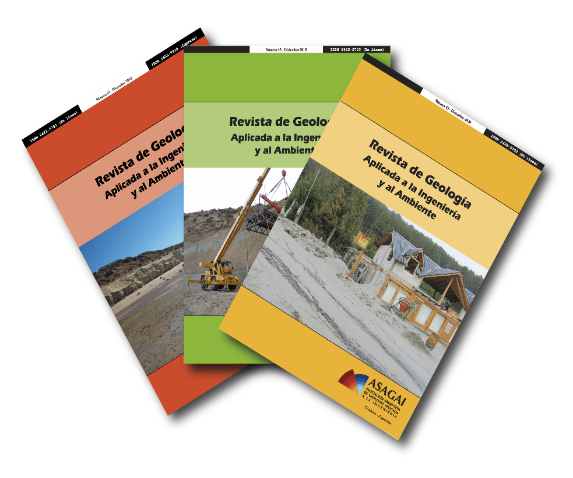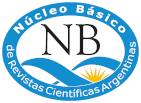Evaluación de los productos de evapotranspiración disponibles en Climate Engine y del algoritmo Support Vector Machine Regression con datos NASA Power
DOI:
https://doi.org/10.59069/24225703ee005Palavras-chave:
inteligencia artificial, productos de reanálisis , productos de satéliteResumo
El manejo hidrológico de un país depende, en gran medida, del conocimiento de las cuencas existentes, del potencial de estas y de la manera de gestionar adecuadamente los excedentes hídricos. En este sentido, es de vital importancia el estudio y análisis de la evapotranspiración (ET) de referencia (ET0), real y potencial (ETp). Por lo que, se torna indispensable evaluar el comportamiento de los diferentes productos de ET que se encuentran disponibles para su uso de manera libre. En este sentido, el objetivo principal de este trabajo es analizar los datos de los modelos existentes en la plataforma Climate Engine (TerraClimate, ERA 5, MERRA-2 y MOD16A2), que posee datos a diferentes escalas temporales y espaciales. Además, evaluar el algoritmo Support Vector Machine Regression (SVR) de inteligencia artificial, aplicado con parámetros obtenidos de NASA Power y con datos locales registrados en la región Pampeana argentina (RPA). En general, se obtuvieron errores entre 0.5 y 1.2 mm d-1 y valores del índice de eficiencia de Nash-Sutcliffe (NSE) entre 0.6 y 0.9 (para ET0); entre 0.4 y 0.7 para ET real y entre 0.6 y 0,9 para ETp. Asimismo, queda demostrado que el modelo más propicio para el cálculo de ET0 como ET real, es el SVR, mientras que para ETp es ERA 5.
Referências
Abatzoglou, J. T., Dobrowski, S. Z., Parks, S. A. y Hegewisch, K. C. (2018). TerraClimate, a high-resolution global dataset of monthly climate and climatic water balance from 1958-2015. Scientific Data, 5,170191. https://doi.org/10.1038/sdata.2017.191
Allen, R. G., Pereira, L. S., Raes, D. y Smith, M. (1998). Crop evapotranspiration-Guidelines for computing crop water requirements. FAO Irrigation and drainage paper Nº56. FAO.
Allen, R., Pereira, L., Howell, T. y Jensen, M. (2011). Evapotranspiration information reporting: I. Factors governing measurement accuracy. Agricultural Water Management, 98(6), 899-920. https://doi.org/10.1016/j.agwat.2010.12.015
Basualdo, A. (2011). Balance hídrico como herramienta de decisión. En S. Occhiuzzi, P. Mercuri y C. Pascale (Coords.), Herramientas para la evaluación y gestión del riesgo climático en el sector agropecuario (pp. 55-63). (1ª ed.). Ministerio de Agricultura, Ganadería y Pesca de la Nación.
Castañeda Calatayud, F. (2020). Análisis del potencial eólico en la Región de Aysén a partir del modelo ERA 5 REANALYSIS. Tesis de grado. Facultad de Ciencias Agronómicas, Universidad de Chile. https://repositorio.uchile.cl/handle/2250/183486
Chia, M. Y., Huang, Y. F., Koo, C. H. y Fung, K. F. (2020a). Recent advances in evapotranspiration estimation using artificial intelligence approaches with a focus on hybridization techniques—a review. Agronomy, 10(1), 101. https://doi.org/10.3390/agronomy10010101.
Chia, M. Y., Huang, Y. F. y Koo, C. H. (2020b). Support vector machine enhanced empirical reference evapotranspiration estimation with limited meteorological parameters. Computers and Electronics in Agriculture, 175, 105577. https://doi.org/10.1016/j.compag.2020.105577
Copernicus Climate Change Service (C3S). (2017). ERA5: Fifth generation of ECMWF atmospheric reanalyses of the global climate. Copernicus Climate Change Service Climate Data Store (CDS), date of access. https://cds.climate.copernicus.eu/
Cristianini, N. y Shawe-Taylor, J. (2000). An introduction to support vector machines and other kernel-based learning methods. Cambridge University press.
Degano, M. F., Rivas, R. E. y Bayala, M. I. (2023). Determinación de la evapotranspiración con datos satelitales y de reanálisis utilizando Google Earth Engine. Tecnología y Ciencias del Agua. https://doi.org/10.24850/j-tyca-15-4-4
Degano, M. F., Rivas, R. E., Carmona, F., Faramiñán, A. M. G. y Olivera Rodríguez, P. S. (2021a). Calibración del producto de evapotranspiración potencial “MOD16A2” para la Región Pampeana Argentina. Boletín Geológico y Minero de España, 132(1-2), 167-174. https://doi.org/10.21701/bolgeomin.132.1-2.017
Degano, M. F., Rivas, R. E., Carmona, F., Niclòs, R. y Sánchez, J. M. (2021b). Evaluation of the MOD16A2 evapotranspiration product in an agricultural area of Argentina, the Pampas region. The Egyptian Journal of Remote Sensing and Space Science, 24(2), 319-328. https://doi.org/10.1016/j.ejrs.2020.08.004
Fan, J., Yue, W., Wu, L., Zhang, F., Cai, H., Wang, X., Lu, X. y Xiang, Y. (2018). Evaluation of SVM, ELM and four tree-based ensemble models for predicting daily reference evapotranspiration using limited meteorological data in different climates of China. Agricultural and Forest Meteorology, 263, 225-241. https://doi.org/10.1016/j.agrformet.2018.08.019
Faramiñán A. M. G. (2022). Estudio de la evapotranspiración y su aporte en el desarrollo de modelos por medio de medidas directas e inteligencia artificial. Tesis doctoral. Facultad de Ciencias Exactas, Universidad Nacional del Centro de la provincia de Buenos Aires.
Faramiñán, A. M. G., Carmona, F., Rivas, R. E., Degano, M. F. y Abadie, P. A. (2021a). Monitoreo de la evapotranspiración real horaria por medio del balance energético y un lisímetro de pesada. Boletín Geológico y Minero de España, 132(1-2), 47-56 . http://hdl.handle.net/11336/164282
Faramiñán, A. M., Degano, M. F., Carmona, F. y Rodriguez, P. O. (2021 b). Estimation of actual evapotranspiration using NASA-POWER data and Support Vector Machine. En 2021 XIX Workshop on Information Processing and Control (RPIC) (pp. 1-5). IEEE. http://dx.doi.org/10.1109/RPIC53795.2021.9648425
Gelaro, R., McCarty, W., Suárez, M.J., Todling, R., Molod, A., Takacs, L., Randles, C., Darmenov, A., Bosilovich, M.G., Reichle, R., Wargan, K., Coy, L., Cullather, R., Draper, C., Akella, S., Buchard, V., Conaty, A., da Silva, A., Gu, W., .... y Zhao B. (2017). The modern-era retrospective analysis for research and applications, Version 2 (MERRA-2). Journal of Climate, 30(13), 5419–5454.
Hargreaves, G. H. y Samani, Z. A. (1985). Reference crop evapotranspiration from temperature. Applied Engineering in Agriculture, 1(2): 96-99. http://dx.doi.org/10.13031/2013.26773
Huntington, J. L., Hegewisch, K. C., Daudert, B., Morton, C. G., Abatzoglou, J. T., McEvoy, D. J. y Erickson, T. (2017). Climate engine: Cloud computing and visualization of climate and remote sensing data for advanced natural resource monitoring and process understanding. Bulletin of the American Meteorological Society, 98(11), 2397-2410. http://dx.doi.org/10.1175/BAMS-D-15-00324.1
Juarez, J., Trentin, G. y Heinen, M. (2018). Determinación de evapotranspiración de referencia a partir de modelos de inteligencia artificial. En X Congreso de AgroInformática (CAI)-JAIIO 47 (pp. 160-168). Sociedad Argentina de Informática e Investigación Operativa.
Liakos, K. G., Busato, P., Moshou, D., Pearson, S. y Bochtis, D. (2018). Machine learning in agriculture: A review. Sensors, 18(8), 2674. https://doi.org/10.3390/s18082674.
Lv, M., Xu, Z. y Lv, M. (2020). Evaluating hydrological processes of the atmosphere–vegetation interaction model and MERRA-2 at global scale. Atmosphere, 12(1), 16.
McCuen, R. H., Knight, Z. y Cutter, A. G. (2006). Evaluation of the Nash–Sutcliffe Efficiency index. Journal of Hydrologic Engineering, 11(6), 597–602. https://doi.org/10.1061/(ASCE)1084-0699(2006)11:6(597)
Monteith J. L. y Unsworth M. H. (1990). Principles of Environmental Physics. (2ª ed.). E. Arnold.
Mu, Q. Z., Zhao y M.S., Running, S. W. (2013). MODIS Global Terrestrial Evapotranspiration (ET) product (NASA MOD16A2/A3). Algorithm Theoretical Basis Document. Collection 5. NASA Headquarters. Numerical Terradynamic Simulation Group, 268. https://scholarworks.umt.edu/ntsg_pubs/268
Orte, F., Lusi, A., Carmona, F., D’Elia, R., Faramiñán, A. y Wolfram, E. (2021,). Comparison of NASA-POWER solar radiation data with ground-based measurements in the south of South America. En 2021 XIX Workshop on Information Processing and Control (RPIC) (pp. 1-4). IEEE. https://doi.org/10.1109/RPIC53795.2021.9648428
Pereyra, F. X. (2003). Ecoregiones de la Argentina. Servicio Geológico Minero Argentino. http://repositorio.segemar.gov.ar/308849217/2953
Ritter, A. y Muñoz-Carpena, R. (2013). Performance evaluation of hydrological models: Statistical significance for reducing subjectivity in goodness-of-fit assessments. Journal of Hydrology, 480, 33–45. https://doi.org/10.1016/j.jhydrol.2012.12.004
Ruhoff, A., de Andrade, B. C., Laipelt, L., Fleischmann, A. S., Siqueira, V. A., Moreira, A. A., Barbedo, R., Cyganski, G.L., Fernandez, G.M.R., Brêda, J.P.L.F., Paiva, R.C.D.d., Meller, A., Teixeira, A.d.A., Araújo, A.A., Fuckner, M.A., Biggs, T. (2022). Global Evapotranspiration Datasets Assessment Using Water Balance in South America. Remote Sensing, 14(11), 2526. https://doi.org/10.3390/rs14112526
Running, S. W., Mu, Q. Z. y Zhao, M. S. (2017). MOD16A2 MODIS/Terra Net Evapotranspiration 8-Day L4 Global 500m SIN Grid V006. NASA EOSDIS Land Processes DAAC, 6. https://doi.org/10.5067/MODIS/MOD16A2.006
Shrestha, N. K. y Shukla, S. (2015). Support vector machine based modeling of evapotranspiration using hydro-climatic variables in a sub-tropical environment. Agricultural and Forest Meteorology, 200, 172-184. https://doi.org/10.1016/j.agrformet.2014.09.025
Weinzettel P. y Usunoff E. (2001). Cálculo de la recarga mediante la aplicación de la ecuación de Darcy en la zona no saturada. En A. Medina, J. Carrera (Eds.), Las caras del agua subterránea. Tomo II (pp. 225–261). IGME.
Downloads
Publicado
Edição
Seção
Licença
Copyright (c) 2023 María Florencia Degano, Raúl Eduardo Rivas

Este trabalho está licenciado sob uma licença Creative Commons Attribution-NonCommercial-ShareAlike 4.0 International License.
Atribuição - Não comercial - Compartilhamento igual (by-nc-sa): não é permitido o uso comercial da obra original ou de quaisquer obras derivadas, cuja distribuição deve estar sob uma licença igual à que rege a obra original.










